




212-216 Santa Monica Blvd.
Architect: Henry Hollwedel

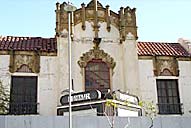
Mayfair Theatre - In the Northridge Earthquake, the Mayfair Theater reportedly lost two walls and had extensive plaster damage.
photo by Michael Grandcolas
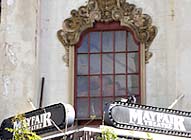
detail
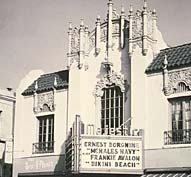
1964 - Majestic Theatre
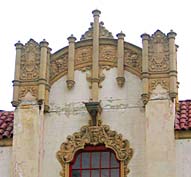
Damage from the Northridge
Earthquake in 1994
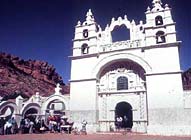
This Churrigueresco church is in Bolivia.
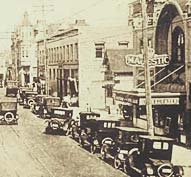
Earlier photo of Santa Monica Blvd.
The Majestic Theatre is on the right.
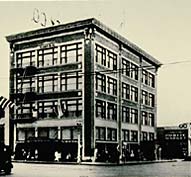
Tegner Building SM Blvd. and 4th St.
Hensheys 1925-1992.
The building was destroyed in the Northridge Earthquake.
First, a word about our sponsor…in 1902, Charles A. Tegner opened a small real estate and insurance office in downtown Santa Monica. He is responsible for many key sites around town. According to city records, the site at 2601 Main Street where the Ocean Park Library was built in 1917 was donated by the Tegner family and was where the original Tegner home once stood. The family name is still affiliated with a local insurance firm.
Majestic architect Henry C. Hollwedel has designed three landmarked buildings in Santa Monica - the Majestic Hotel; the earthquake damaged Henshey’s Department Store and landmark #24. Santa Monica Bay Woman’s Club Building. The Women’s Club at 1210 4th St is the only one of the three that is still intact. Henshey’s at 4th & Santa Monica was demolished after the earthquake to be replaced for a short-lived Toys ‘R Us.
Originally known as the Majestic Theatre, the entertainment hall at 212-216 Santa Monica Blvd. opened on December 12th, 1911, as a live theater and opera house. At the time, it was quite the architectural icon. The Spanish colonial revival style of the theatre's current facade was very rare prior to its popularization by architect Bertram Goodhue, who used the style for many of the buildings at the California Pacific Exposition of 1915 in San Diego's Balboa Park. What made the Majestic so unique were its Churrigueresque embellishments.
If you’ve been walking around Santa Monica, you’ve come to know Spanish Colonial Revival style - smooth stucco surfaces, low pitched tile roofs and decorative ironwork on the window faces.
Churrigueresco is a Spanish Rococo architectural style from the late Baroque period. The style was named for the Churriguera family of Spain, as many members of this family were architects and sculptors. Churrigueresco is characterized by elaborate ornamentation and open, curving shapes. This style revels in a plethora of compressed ornamentation, surfaces bristle with baroque swirls and such devices as broken pediments, undulating cornices, reversed volutes, insert shields, balustrades, stucco shells, and garlands.
When the Majestic became the Mayfair Theater, it was a single screen movie theater that seated 602. Featured movies were the standard Hollywood fare that hit neighborhood theatres after it's initial first run engagement.
The Mayfair’s 1973 remodel occurred shortly after the Fox Belmont Theatre in Los Angeles was damaged by fire and subsequently demolished. Milt Larsen used some of the surviving movable decorations from that theater when he renovated the Majestic and converted it into the Mayfair Music Hall. It was again remodeled in 1988 and was in divine condition.
The architecturally delightful Mayfair Theater suffered extensive internal damage to supporting walls and ceilings during the Northridge Earthquake. According to the Route 66 Newsletter, Roadsigns “The Mayfair Theater on Santa Monica Boulevard, Route 66, in Santa Monica has reportedly lost two walls and had extensive plaster damage.”
Mr. Karl Schober, current owner and a descendant of the original Mayfair owner, went before the Landmarks Commission requesting permission to demolish his building, stating safety and structural concerns due to damage caused by the earthquake. The Landmarks Commission is fighting to save the structure, which has been under scaffolding since the 1993 Earthquake.
The theater’s last tenant, who had been featuring live acts like
Siouxsie and the Banshees, returned the facility to Schober a few days
before the earthquake. Apparently, under the lease Schober had with tenants,
it was their responsiblity to take care of earthquake retrofitting. Schober
said, "They didn't"
Here are some memories of the Mayfair Theater…
It was a gem, with a balcony. I vividly remember the two life size masques
on either side of the proscenium arch, Comedy and Tragedy. It was tiny
as movie theaters go, but it had the architectural details of the big
ones.
posted by E.L. on Mar 18, 2004 at 11:40pm
**
Prior to its renovation as The Mayfair, The Majestic hosted the West
side’s rowdiest group of teens and pre-teens for Saturday matinees
during the late '50s and early '60s. Particularly when horror films were
screened, flattened popcorn boxes filled the air, and soda pop and other
liquids fell from the balcony onto the unfortunates seated below. The
place had a dumpy, raunchy feel, and was considered inferior to the Criterion,
Fox Venice, Picwood, Culver, even lower than the Meralta, Palms, or Bundy.
I remember The Majestic with fondness.
posted by rlgoldst on Dec 24, 2004 at 10:59am
**
I frequented the Majestic/Mayfair Theatre from the mid-60's to early 70's, the theatre would show a lot of the standard Hollywood fare when it hit neighborhood theatres after it's initial first run engagement in Hollywood or Beverly Hills. I recall seeing a variety of films there, from the mainstream such as BUTCH CASSIDY AND THE SUNDANCE KID and THE LOVE BUG to more exploitation type films like NIGHT OF THE LIVING DEAD and THE CORPSE GRINDERS. Don Knotts comedies always seemed to open here for some reason or other. There did tend to be a seedier/rowdy crowd attending the Mayfair than the more upmarket crowd at the Criterion and El Miro. Occasionally the theatre would put on a special all night show that began at midnight and I remember going to see an all-nighter of 200 MOTELS, WATTSTAX, GIMME SHELTER and one other rock type of film of which title I can't recall in 1972. The theatre was absolutely packed and they served some kind of breakfast at the end of the marathon. I guess I was too tired to recall what was on the menu but it must have been something quite minimal.
I worked briefly as an usher at the Mayfair just prior to it closing
down as a movie theatre in 1973. I recall changing the marquee for double
features like HIGH PLAINS DRIFTER and PLAY MISTY FOR ME, A CLOCKWORK ORANGE
and PERFORMANCE, to name a couple. The theatre was still in pretty good
condition and there were kind of spooky corridors that would run along
the outside of the auditorium to the back stage area that only staff had
access to. The projection booth was a tiny room at the very top of the
steeply inclined balcony that would be quite a chore to carry film cans
up to. The balcony had little alcoves on either side of it with about
8 seats in each alcove, sort of like Royal Boxes. But no royalty ever
used these seats to my knowledge, so they were open to the public. When
the theatre closed in the summer of '73 I was transferred to the nearby
Nuart Theatre in West Los Angeles to continue my usher duties (both theatres
were then owned by the Sales (sp?) Brothers, who also had a side business
in adult films.)
posted by mv on Feb 6, 2005 at 5:06pm
Memories are shared courtesy of the Cinema Treasures website. For more
info go to http://www.cinematreasures.org/theater/1984/